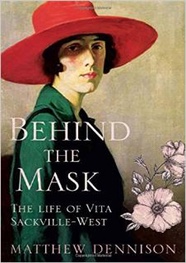Why Vita Sackville-West Was Not a Gay Icon During Her Lifetime

‘Few things are more distasteful than veiled hints,’ wrote Vita Sackville-West in 1943. She was referring to rumours of lesbianism on the part of aristocratic Spanish saint Teresa of Avila, one of the two subjects of her bestselling biography The Eagle and The Dove. It was, under the circumstances, a curious statement. In the middle years of the Second World War, lesbianism remained a taboo subject for the British reading public. Even in the hands of a popular and well-respected author like Vita, such a subject could be addressed only with circumspection, through precisely such veiled hints as Vita professed to deplore.
 Added
to which, Vita herself had strongly lesbian instincts. Married to
writer, diplomat and politician Harold Nicolson, she had nevertheless
enjoyed numerous same-sex affairs. She was not ashamed of her
sexuality, though she took pains that it remain a secret outside her
immediate circle. In keeping with current mores, she valued her
respectability and her reputation as an Establishment literary
celebrity. Most of all she valued her privacy. Vita’s
transgressions were private transgressions. As she wrote in the best
of her novels, All
Passion Spent,
in 1930, ‘Pleasure to her was entirely a private matter, a secret
joke, intense, redolent but as easily bruised as the petals of a
gardenia.’ Vita was secretive by nature. But time and again in her
writing – from her novels and poetry to her journalism and
nonfiction – she made glancing references to lesbianism. Invariably
her chosen means were veiled hints.
Added
to which, Vita herself had strongly lesbian instincts. Married to
writer, diplomat and politician Harold Nicolson, she had nevertheless
enjoyed numerous same-sex affairs. She was not ashamed of her
sexuality, though she took pains that it remain a secret outside her
immediate circle. In keeping with current mores, she valued her
respectability and her reputation as an Establishment literary
celebrity. Most of all she valued her privacy. Vita’s
transgressions were private transgressions. As she wrote in the best
of her novels, All
Passion Spent,
in 1930, ‘Pleasure to her was entirely a private matter, a secret
joke, intense, redolent but as easily bruised as the petals of a
gardenia.’ Vita was secretive by nature. But time and again in her
writing – from her novels and poetry to her journalism and
nonfiction – she made glancing references to lesbianism. Invariably
her chosen means were veiled hints.
Throughout her life Vita Sackville-West’s writing had a strongly autobiographical quality. Remembered today as a gardener of genius and chatelaine of Sissinghurst Castle in Kent, in southeast England, Vita was first and foremost a creative artist. From childhood she aspired to literary greatness: later she was sufficiently honest with herself to acknowledge that greatness would always elude her, but she continued to write.
There are obvious pitfalls for the literary biographer in interpreting one’s subject’s written output as self-revelatory. Given Vita’s working methods in writing fiction, the frequency of such coded references within her work and the recurrence in her writing of forms of self-portraiture, it is justifiable to examine those references in order to reach a fuller picture of this remarkable woman. Vita herself offered an inadvertent warning to any future biographer when she edited the diary of her redoubtable seventeenth-century kinswoman Lady Anne Clifford: ‘Few tasks of the historian or biographer can be more misleading than the reconstruction of a forgotten character from the desultory evidence at his disposal.’ In that instance, Vita’s ‘desultory evidence’ consisted of letters and diary entries. Happily she left her own biographer more extensive evidence in her published and unpublished writing. As Vita wrote of St Teresa, ‘every point concerning so complex a character and so truly extraordinary a make-up is of interest as possibly throwing a little extra light on subsequent behaviour’.
In a poem to a former lover, Vita described staring into a pool. She ‘looked into its waters, seen there my own image/ As an upturned mask that floated/ Just under the surface, within reach, beyond reach.’ Gazing at reflections of herself, invariably of her own devising, was one of Vita’s principal preoccupations in her writing. Repeatedly she used her writing as a means of explaining herself to herself. She never fully succeeded. Certainty continued to lie ‘within reach, beyond reach,’ though Vita relished the challenge of attempting to bring it fully into focus.
Her life was one of considerable material privilege. Born into an ancient English aristocratic dynasty in the dog days of the Victorian era when, in Britain, aristocracy retained last vestiges of power, Vita wrestled lifelong with issues of dispossession and thus the threat of rudderlessness. As a daughter she could inherit neither her father’s title nor the ancestral home, Knole, which she loved with a fierce possessiveness; her father had no son and so the great house and its title disappeared sideways to a cousin. Her earliest self-identity branded her a scion of Knole, the latest in a long line of Sackville-West grandees. Inheritance laws challenged that identity. For the remainder of her life, Vita struggled to find an alternative mask. She did so half-heartedly, unable to cast aside Knole’s patrician allure. Instead over and over again in her writing she reimagined herself as she wished she might have been: in full possession, dominant, empowered. Vita’s writing is a sustained exercise in wish fulfilment and she, rather than any reader, was the intended beneficiary of her self-fictions. Often she wrote in veiled hints – for the truth stubbornly resisted her determination to change it.